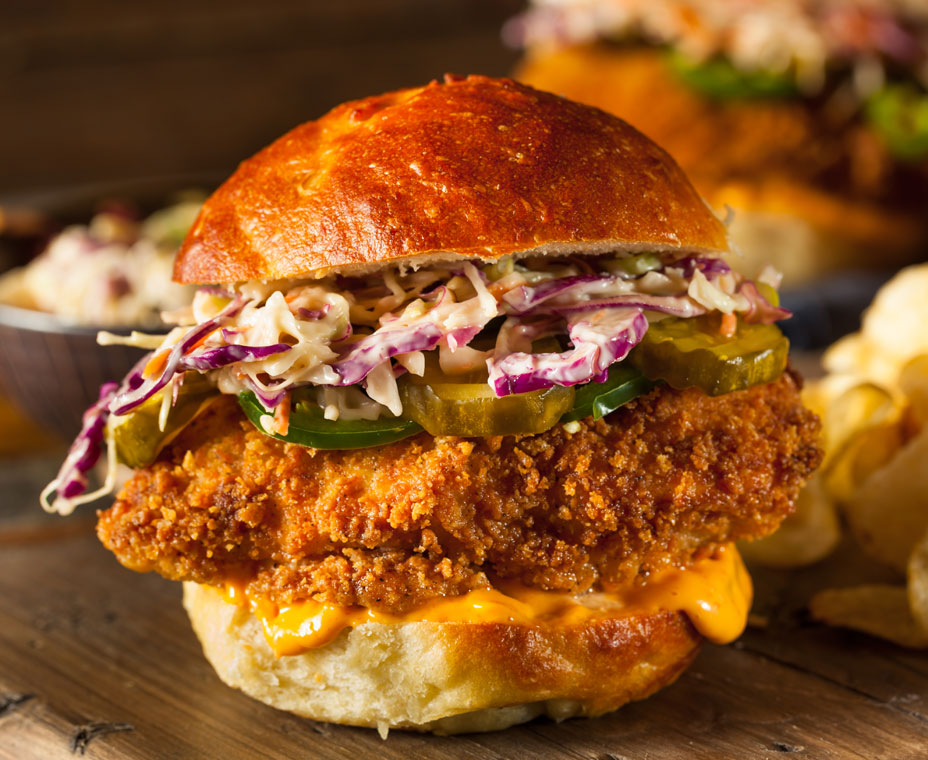In 1980, Americans consumed an estimated 48 pounds of chicken per person each year. This year, the National Chicken Council projects that figure will reach an astonishing 92 pounds.
By contrast, consumption of beef actually dropped significantly, from 77 to 56 pounds, during this same period. Our nation today consumes more chicken than any other single protein. The council noted that in 2015, the U.S. produced almost 9 billion broiler chickens.
That, needless to say, is a whole lot of bird.
We’re not particularly fussy about how we consume the stuff, either. Whether grilled and diced on salads or in stirfries, baked and served with mashed potatoes, rotisserie-spun and accompanied by green or root vegetables, boiled in soups, or broiled in the oven, chicken is a highly versatile protein.
And then, of course, there’s deep-frying. Perhaps no other preparation is so thoroughly well-suited to chicken’s inherent strengths. By nature, chicken serves as a clean, open canvas for flavor experimentation and delivery, and the process of dredging it in batter and submerging it in oil creates something far more than the sum of its simple parts. Indeed, oil itself helps to distribute and intensify all kinds of flavors.
Fried chicken also plays into a host of today’s food obsessions; let’s take a look at each of them in turn.
The comfort food trend is unquestionably a response to the frenzied world in which we’re living. As consumers reckon with challenging personal schedules, job responsibilities, child-care duties, unread email, and other complexities of modern life, foods like fried chicken fill an emotional, as well as nutritional, void. Indulgence comes into play because consumers want to reward themselves occasionally, and not terribly extravagantly, within the context of their busy lives.
Interest in artisan products, meanwhile, is driven by a desire for foods and beverages that bear some sort of distinct human touch; for example, small-batch whiskeys that have been specially aged and handled for exceptional quality; honeys, butters, breads, and cheeses that are minimally processed and made with all-natural ingredients; and handcrafted beers that show evidence of a brewer’s creativity and attention to detail.
As for flavor adventure, fried chicken itself is also being treated as a blank canvas that chefs and menu developers can paint with a host of flavors using sauces, marinades, brines, rubs, and other tricks of the trade. A year or two ago, the last time I wrote about chicken in this space, I suggested that fried chicken could be coated in chocolate or otherwise given a sweet treatment. The idea might have seemed a bit outlandish at the time, but the concept—and variants of it—has caught on rather broadly in the intervening years.
Consider, for instance, the way more purveyors are employing brines and marinades to impart a broad spectrum of global flavor profiles to standard fried chicken dishes. Marinating the meat in lemongrass, ginger, and garlic before frying creates what amounts to Thai fried chicken, while soaking the stuff in piri piri sauce—a mix of crushed chilies, citrus peel, onion, pepper, salt, lemon juice, bay leaves, paprika, pimiento, basil, oregano, and tarragon—produces a distinctly Portuguese version.
We’re also seeing a trend toward Korean fried chicken in which the bird is dipped in a batter that creates a cracker-thin crust that practically shatters when bitten into.
Fuku in New York offers a spicy chicken sandwich with a topping of julienned daikon radish that adds bright and vinegary notes, while at Aburaya Japanese Fried Chicken in Oakland, California, the menu is highlighted by the namesake dish—also known as karaage—in which the chicken is marinated in ginger, garlic, and soy sauce, then coated in potato starch before being fried.
Fried chicken’s versatility can also make it a great carrier for regional American flavors, which today are quite trendy. We’ve seen versions concocted with a Southern sweet tea brine spiked with lemon and Tabasco for a citrusy, spicy treat. We’re also seeing Georgia-style honey mustard barbecue sauce, Pacific Northwestern apple cider vinegar, and Hawaiian-style sweet and sour pineapple, mango, and tamarind seeping into our preferred poultry.
The great thing about tricking out fried chicken is that the possibilities are near limitless. In San Diego, The Crack Shack has uncaged a signature sandwich called the Coop Deville, which features pickled Fresno chilies, lime mayo, and napa cabbage, all served on brioche. And at The Organic Coup in Pleasanton, California, the menu includes Mary’s Organic Air-Chilled Chicken, which is soaked in buttermilk and fried in coconut oil with a breading that includes whole-wheat flour, panko, cayenne, black pepper, parsley, and oregano.
That, friends, is the state of play when it comes to fried chicken today. What has your establishment done new or differently with fried chicken? I’d love to hear about it. Drop me a line at marc@qsrmagazine.com.











